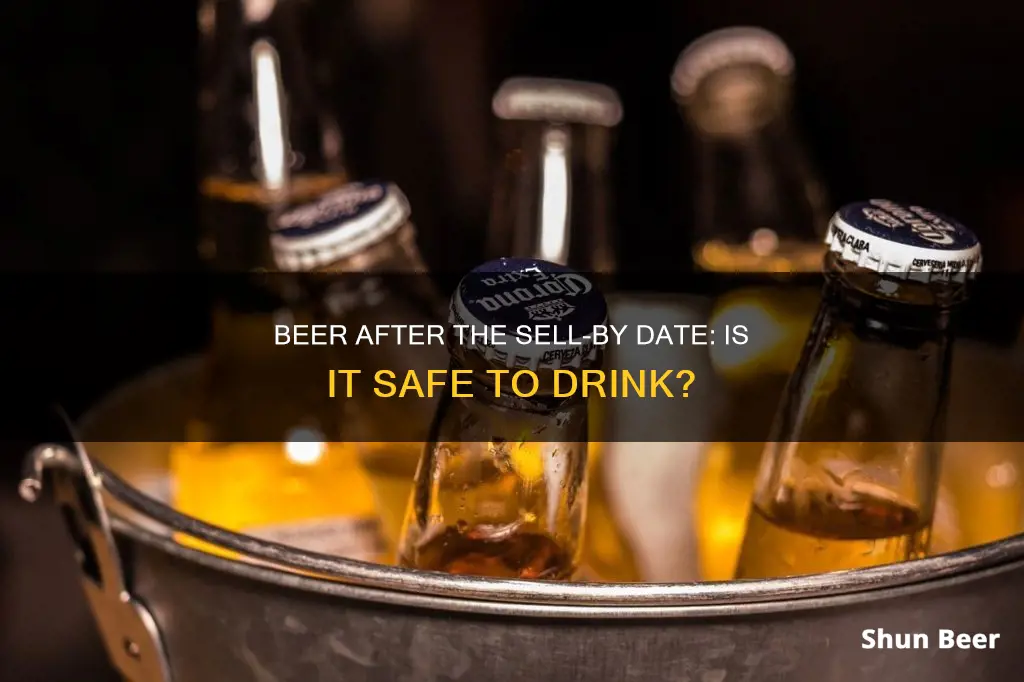
Beer is known to have a 'best before' date, which is different from a 'use by' date. While it is not harmful to drink beer past its 'best before' date, the taste and quality of the beer will deteriorate over time. The time span for which a beer will remain drinkable depends on the type of beer and how it is stored. Beers with higher alcohol content, such as imperial stouts and porters, can last for 5-10 years or more. On the other hand, normal beers like lagers, IPAs, and pale ales are typically drinkable for 6-24 months after their 'best before' date if stored in the fridge. It is important to note that beer is sensitive to light and temperature changes, so it should be stored in a cool, dark place to maintain its flavour.
| Characteristics | Values |
|---|---|
| Safety | Beer is generally safe to drink past its sell-by date |
| Taste | The taste of the beer will deteriorate over time |
| Storage | Beer should be stored in a cool, dark place |
| Sensory test | If it smells and tastes like beer, it's probably fine to drink |
| Expiry date type | Beer has a 'best before' date, not a 'use by' date |
| Effect of time | Beer will gradually lose its flavour and aroma over time |
| Effect of temperature | Beer should be stored cold; temperature fluctuations can adversely affect its flavour |
| Effect of light | Beer is sensitive to light; exposure to light can create a skunked flavour |
What You'll Learn
- Beer won't be harmful past its sell-by date, but the taste will deteriorate over time
- Beer should be stored in a cool, dark place to avoid it going skunky
- Beers with higher alcohol content will last longer than those with lower alcohol content
- Beers with darker malts will last longer than those with lighter malts
- Hazy beers will have a shorter shelf life than bright or big and dark beers

Beer won't be harmful past its sell-by date, but the taste will deteriorate over time
Beer has a 'best before' date, which is different from a 'use by' date. While it's recommended to adhere to 'use by' dates for food safety, 'best before' is more of a guideline on quality. This means that beer won't be harmful past its sell-by date, but the taste will gradually deteriorate over time.
Beer is produced with a 'best before' date, which indicates when the beer will start to lose its quality. The taste will change, and the beer won't be as good as it would have been before the date. However, it won't make you sick or cause any harm. In fact, some beers can even improve with age, similar to how wine and whiskey mature over time. Richer and higher ABV varieties, such as porters and stouts, can get better with age if stored in cool, dark conditions.
The rate at which beer deteriorates depends on the type of beer and how it is stored. A standard lager, IPA, or ale will typically last around 6 months to 2 years past its best-before date if kept in the fridge, and 6-9 months if stored in a cupboard. On the other hand, high-alcohol beers, such as imperial stouts and barley wines, can last 5-10 years or more, depending on the specific beer.
It's important to note that beer is sensitive to light and temperature changes. To maintain its taste for as long as possible, beer should be stored in a cool, dark place, and fluctuations in temperature should be avoided.
In summary, while beer won't be harmful past its sell-by date, the taste will gradually deteriorate, and it's best to consume it within the recommended time frame for optimal flavour.
Beer and Bowel: The Diarrhea Connection
You may want to see also

Beer should be stored in a cool, dark place to avoid it going skunky
Beer is produced with 'best before' dates, which are more of a guideline on quality than a rule. The flavour and aroma of beer can change over time, and it's usually recommended to drink IPAs sooner rather than later. However, some beers can improve with age, like porters and stouts. These richer, higher ABV varieties can get better if they're kept in cool, dark storage like a basement or cellar.
If you want your beer to age well, it's important to store it in a cool, dark place. This is because the phenomenon of beer developing a putrid taste and smell, known as "skunking", is caused by light exposure. When hops are boiled down to make beer, they release chemical compounds called Iso-Alpha Acids. These are bitter on their own, but when exposed to sunlight, they break down and interact with other molecules in the beer to produce a molecule that's almost identical to the one in a skunk's spray.
UV rays can reach beer through glass bottles, so it's important to keep beer out of the sun. Brown bottles do the best job at protecting the beer, while green bottles are more susceptible, and clear glass bottles are the most susceptible to skunking. Cans and kegs are even better at protecting against UV exposure.
So, if you want to avoid your beer going skunky, keep it in a cool, dark place, preferably in brown bottles or cans.
Beer and Valacyclovir: Is It Safe to Mix?
You may want to see also

Beers with higher alcohol content will last longer than those with lower alcohol content
Beer typically has a 'best before' date, which is a guideline on quality rather than safety. This means that the beer will start to lose its quality after the stated date but can still be consumed. The taste and aroma of the beer will change over time, and it may lose its fizz. However, the alcohol and hops in beer act as preservatives, preventing bacterial growth that can cause sickness. Therefore, beers with higher alcohol content will last longer than those with lower alcohol content.
Beers with higher alcohol content, such as barley wines and imperial stouts, are sometimes brewed with aging in mind. Brewers intend for these beers to be aged for a couple of years, and they can improve with age if stored in cool, dark conditions. On the other hand, beers with lower alcohol content, such as IPAs, are best consumed fresh. The volatile aromas from hops, which give IPAs their characteristic hoppy aroma, tend to dissipate over time. Therefore, an IPA that is a few months old may have lost most of its hop characteristics.
The shelf life of beer also depends on how it is stored. Beer should be stored in a cool, dark place, such as a refrigerator or a basement. Exposure to light and temperature fluctuations can negatively affect the flavour of the beer. Additionally, the type of bottle used for packaging can impact the beer's shelf life. Brown glass bottles provide the best protection against ultraviolet light, followed by green and clear glass, which offer minimal protection.
In summary, beers with higher alcohol content will last longer than those with lower alcohol content due to the preservative effects of alcohol. However, proper storage conditions are also crucial in ensuring the longevity and quality of the beer.
Beer and Minors: Is Non-Alcoholic Beer Safe?
You may want to see also

Beers with darker malts will last longer than those with lighter malts
Beer is a complex and intricate beverage with many varieties. While beers are produced with expiry dates, you don't always have to adhere to these. Beers with a 'best before' date are more of a guideline on quality rather than safety. The beer will start to lose its quality after the stated date, but you can still drink it. The main difference is that it won't taste as good.
Some beers, like people, can improve with age. Richer and higher ABV varieties of beer, such as porters and stouts, can get better with age. This happens when they are kept in cool, dark storage conditions like a basement or cellar. Beers with darker malts, such as porters and stouts, are made from barley malt that has been darkly roasted. The darker the malt, the darker the beer. The longer roasting time of darker malts means that these beers will last longer than those with lighter malts.
On the other hand, IPAs, especially the hoppy ones, gradually lose their flavour and aroma over time and are best drunk sooner rather than later. Lighter beers tend to have a higher proportion of hops, which are roasted for a shorter time and at lower temperatures.
The difference in the length of time that dark and light beers last is caused by the organisms used in the brewing process. When yeasts are used to produce flavours in speciality beers, they change the flavour over time, living in the beer for years, consuming sugar and oxygen to ferment its ingredients.
In summary, beers with darker malts will last longer than those with lighter malts due to the longer roasting process and the use of different ingredients.
The Magic Behind Beer Engines: How Do They Work?
You may want to see also

Hazy beers will have a shorter shelf life than bright or big and dark beers
Hazy beers, such as IPAs, are best consumed fresh. They should ideally be drunk within a month of packaging and preferably no later than three months after packaging. This is because the degradation of hops in hazy beers occurs rapidly.
The difference in shelf life is due to the brewing process and the ingredients used. Hazy beers, such as IPAs, often use hops to create their distinctive flavour and aroma. However, hops begin to degrade quickly, causing hazy beers to lose their flavour and aroma over time. On the other hand, darker and stronger beers tend to have a longer shelf life as they can benefit from ageing. The richer and higher ABV varieties of beer, such as porters and stouts, can improve with age if kept in cool, dark storage conditions.
It is important to note that while hazy beers have a shorter shelf life, they can still be consumed past their "best before" date. Beer does not technically spoil, and it is safe to consume past the expiration date. However, the flavour and quality may degrade over time, resulting in unpleasant tastes and aromas.
Beer and Cirrhosis: What You Need to Know
You may want to see also
Frequently asked questions
Yes, you can. Beer has a 'best before' date, which is a guideline on quality rather than safety. It won't be dangerous to drink, but the taste will deteriorate over time.
It depends on the type of beer and how it's stored. A standard lager will last around 6 months to 2 years after the best-before date if kept in the fridge, and 6-9 months if kept in the cupboard.
There will be a bad aroma, and it might be missing the usual 'pssst' sound and foaming when you open it. You could also check the bottom of the bottle for excessive sediment, which could contribute to a poor taste.
Beer should be stored in a cool, dark place, ideally in the fridge at a temperature of 2-7 degrees Celsius.







